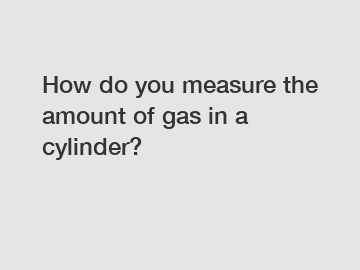How do you measure the amount of gas in a cylinder?
How do you measure the amount of gas in a cylinder?
Gas cylinders are commonly used to store and transport various gases, such as oxygen, helium, and acetylene, for a wide range of applications. Whether it's for industrial purposes, medical use, or even for recreational activities like scuba diving, it is important to know the amount of gas remaining in a cylinder to ensure proper usage and safety. In this article, we will explore the different methods used to measure the amount of gas in a cylinder.
• Liquid Level Measurement.

Liquid level measurement is one of the most common methods used to measure the amount of gas in a cylinder. It involves using a dip tube, also known as a sight glass or a liquid level gauge, which is attached to the cylinder's valve. The dip tube extends into the liquid phase of the gas stored inside the cylinder. By observing the level of the liquid inside the tube, one can estimate the amount of gas remaining. This method is commonly used for cryogenic gases, such as nitrogen, and liquefied petroleum gases (LPG).
• Pressure Measurement.
Pressure measurement is another widely used method to determine the amount of gas in a cylinder. It involves using pressure gauges that are attached to the cylinder's valve. The pressure gauge indicates the pressure of the gas inside the cylinder, which can then be used to estimate the amount of gas remaining. This method is suitable for gases that remain in a gaseous phase under normal conditions, such as oxygen and argon. It is important to note that pressure readings can vary with temperature, so corrections may need to be made accordingly.
• Weight Measurement.
Weight measurement is a more direct and accurate method to measure the amount of gas in a cylinder. It involves weighing the entire cylinder when it is full and then weighing it again when it is empty or near empty. By subtracting the weight of the empty cylinder from the weight of the full cylinder, one can determine the weight of the gas remaining. This method is particularly useful for gases that cannot easily be liquefied or gases that are prone to changes in pressure and temperature.
• Ultrasonic Measurement.
Ultrasonic measurement is a modern and non-invasive method used to measure the amount of gas in a cylinder. It involves using ultrasonic sensors that emit sound waves and measure the time it takes for the sound waves to bounce back from the gas surface. By knowing the speed of sound and the time taken for the sound waves to return, the level of gas can be determined. This method is particularly useful for gases that are hazardous or difficult to access manually.
In conclusion, there are various methods available to measure the amount of gas in a cylinder. Liquid level measurement, pressure measurement, weight measurement, and ultrasonic measurement are among the commonly employed techniques. The choice of method depends on the type of gas being stored, the level of accuracy required, and other specific factors related to the application. Ultimately, accurate measurement of gas levels is crucial for efficient usage and ensuring the safety of individuals and the environment.
If you have any further questions or require assistance with measuring gas in a cylinder, please do not hesitate to contact us. Our team of experts will be more than happy to provide guidance and support.
The company is the world’s best 60 kg cng cylinder capacity supplier, lpg cylinder supplier, high quality skid container supplier. We are your one-stop shop for all needs. Our staff are highly-specialized and will help you find the product you need.
184
0
0


Comments
All Comments (0)